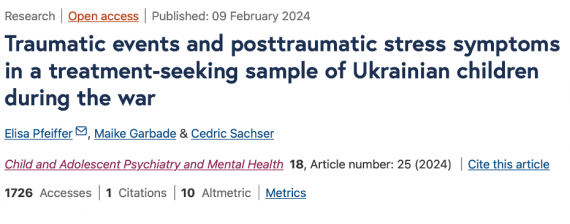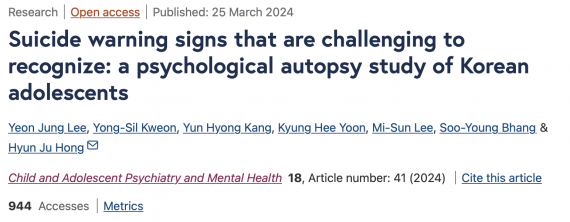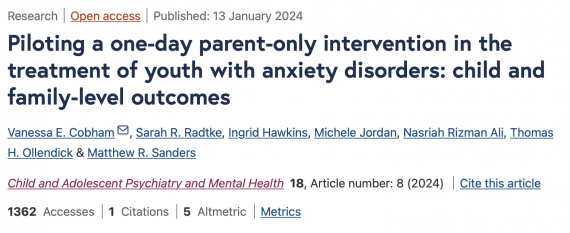CAPMH Corner (Updated Jun 2024)
By: Lakshmi Sravanti, India, Deputy Editor, CAPMH
Child and Adolescent Psychiatry and Mental Health (CAPMH) is the official IACAPAP Journal. The "CAPMH Corner" of the June 2024 issue of IACAPAP Bulletin summarizes the following three studies recently published in CAPMH – Traumatic events and posttraumatic stress symptoms in a treatment‑seeking sample of Ukrainian children during the war (Pfeiffer et al., 2024), Suicide warning signs that are challenging to recognize: a psychological autopsy study of Korean adolescents (Lee et al., 2024) and Piloting a one‑day parent‑only intervention in the treatment of youth with anxiety disorders: child and family‑level outcomes (Cobham et al., 2024).
Pfeiffer et al., (2024) highlight the need to investigate the Ukrainian children and adolescents’ self-and caregiver reported trauma history and their PTSD/ CPTSD prevalence rates since 2022. The current study is a part of the “TF-CBT Ukraine” project (Pfeiffer et al., 2023) which aims to implement and evaluate the evidence-based trauma-focused treatment “Trauma-focused Cognitive Behavioral Therapy” (TF-CBT) (Cohen, Deblinger and Mannarino, 2017) in Ukraine during the war.
The Ukrainian therapists in the TF-CBT Ukraine project received a training on how to implement, analyze and interpret the CATS-2 (Child and Adolescent Trauma Screen Second Version) measure. They (n=67) recruit participants (children/ adolescents and caregivers) for assessment and TF-CBT treatment. Besides CATS-2, they use an unstandardized questionnaire to collect socio-demographic information such as age, gender and current location. They conduct the descriptive statistics and bivariate correlations (Pearson correlation coefficients (r)) and Φ-correlations to analyse the data.
The authors study a sample of 200 children, adolescents and young adults, the majority of whom (n = 115, 62.5%) were still located in Ukraine. They note that 38.0% (n=76) of the sample were male; Mage = 12.01 (SD = 4.05; range 4–21). They report that almost 70% (n = 123) of the participants fulfilled the DSM-5 PTSD criteria, 31% (n = 56) fulfilled the ICD-11 PTSD criteria and 21% (n = 38) the ICD-11 CPTSD criteria. They note an even higher rate of PTSD (95%) in preschool children. They compare self-and caregiver reports on traumatic events and PTSD/CPTSD severity scores that indicated moderate to high correlations between the patients and their caregivers (r = 0.710–0.767). They report that the participants aged 7 years or older reported on average 4.23 different PTEs (SD = 2.54, range 0–12) – the most frequently reported PTEs being “war” (n = 112, 68.7%), “bullying” (n = 71, 39.7%), and “witnessing domestic violence” (n = 68, 38.9%); and the least frequently reported PTE being “online sexual violence/ abuse” (n = 11, 6.1%). Regarding preschool children, they note that caregivers reported an average of 4.38 (SD = 2.80, range 1–10) PTEs – the most often reported PTEs being “being in a war situation” (n = 15, 71.4%), “witnessing a violent attack” (n = 9, 42.9%), “witnessing family violence” (n = 8, 38.1%) and “sudden loss” (n = 8, 38.1%); the least frequently reported PTEs were being touched on private parts” (n = 1, 4.8%) and “sexual violence/abuse” (n = 1, 4.8%). The team noted a moderate to high correlation between self-report and caregiver-report for the traumatic events
The authors highlight the strengths of their study – use of a state-of-the-art validated measure in different languages, assessing PTSD and CPTSD in self- and caregiver reports in a naturalistic and heterogeneous sample, focusing on lifetime traumatic experiences and not solely war experiences. They also acknowledge the limitations of – small sample with higher representation of girls; possibility of selection bias; exclusive assessment only trauma and PTSD; severity & frequency of traumatic events not being assessed; use of the Ukrainian CATS-2 version that wasn’t validated and some aspects – such parents’/caregivers’ psychopathology, parenting, possible protective factors etc not being assessed. They conclude that the Ukrainian children and adolescents seeking for treatment have experienced multiple other traumatic events in addition to war, which should be taken into account in trauma-focused psychotherapy.
Lee et al., (2024) discuss the complex dynamic of suicide in adolescents and establish a need to conduct a psychological autopsy study in Korean adolescent. They carry out this cross-sectional descriptive study by involving parents (5 fathers and 31 mothers) of 36 adolescents who died by suicide from August 2015 to July 2021.
The team collects qualitative and quantitative data through semi-structured interviews using the Korean Psychological Autopsy Checklist for Adolescents (K-PAC-A) (Jeon et al., 2018) and assessment tools such as the Kiddie-schedule for affective disorders and Schizophrenia- Present and Lifetime-Korean Version (K-SADS-PL-K), Korean version of the Barratt Impulsiveness Scale-11 (K-BIS- 11), Korean version of Beck Depression Inventory-II (K-BDI-II), Korean attention Deficit/Hyperactivity disorder (ADHD) rating scale-IV (K-ARS-IV), Internet addiction proneness scale for Youth: Observer Rating Scale (KO scale), and Adjective scale to assess the personality types. They analyze the data using IBM SPSS Statistics Version 28.0 (IBM Corp., Armonk, NY, USA) with p-value < 0.05 as statistically significant and investigate gender differences using the Mann-Whitney U test and Fisher’s exact test.
They report the mean age of the adolescents as 16.1 years (SD 2.0) and home as the place of death for most of the adolescents. They note that most common method of suicide was jumping from a height (72.2%), followed by hanging (16.7%), the majority did not ask anyone for help before death (97.2%), 80.6% of all adolescents exhibited one or more warning (verbal, behavioural or emotional) signs of suicide and about half (52.8%) left a suicide note. They mention that most adolescents (97.2%) were diagnosed with a major mental disorder in the three months before death and a significant proportion (80.6%), with affective disorder; more than half of them (55.6%) were diagnosed with comorbidities. They report the most common comorbidity as depressive disorder followed by generalized anxiety disorder. They note that 47.2% experienced psychiatric intervention, while three adolescents (8.3%) received inpatient treatments at the Department of Psychiatry and only three (8.3%) received regular medication treatments. They mention that while many parents (50%) had a psychiatric diagnosis before their offspring died; 25% had a familial history (including parents and grandparents) of suicide.
The authors acknowledge the limitations of their study of – small sample size, lack of control groups, assessments being completed by parents and possibility of recall bias. They conclude that most of the adolescents had mental disorders, were not highly impulsive and were continuously exposed to adverse family-related events during their developmental years. They add that it was challenging to identify the risk factors before death because (1) the adolescents had avoidant and submissive personality traits and were not to express their feelings and thoughts to others, and (2) they did not exhibit behavioral problems. They recommend future studies involving peers in psychological autopsies despite the potential ethical and economic challenges, suggesting that it can be a practical method for screening and intervening with adolescents affected by a friend’s suicide.
Cobham et al., (2024) underscore the role of parents in the etiology of childhood anxiety and sibling anxiety as a possible treatment outcome. They examine the effects of a parent focused intervention on the siblings of target children. They evaluate two different versions of a parent-only intervention (Fear-Less Triple P; FLTP; [Cobham and Sanders, 2015]): a one-day intensive workshop format (~ 6 h clinical contact) and a standard 6-week group format (as a control).
The team recruits participant families through the media and local schools in metropolitan Brisbane between September 2015 and July 2017. Their inclusion criteria require children to be 7–14 years of age and to meet diagnostic criteria for a primary diagnosis of a DSM-5 anxiety disorder. They recruit a final sample of 73 children and adolescents (mean age = 8.40 years, 74% male sex) and their parents. They report that 64 had one or more siblings; siblings ranged in age from 2 to 26-years-old (M = 8.09, SD = 4.14); 52% were male sex. They allocate parents randomly to either the six-week group (n = 34) or one-day workshop (n = 39) condition via a computerized random generator with a 1:1 ratio. They conduct post-treatment and follow-up interviews either face to face or via telephone. They note a retention rate at the post-treatment, 6-month and 12-month time-points for the 6-week group as 85%, 82% and 71% and for those assigned to the one-day workshop as 77%, 72%, and 59% respectively.
The assessments include The Anxiety Disorders Interview Schedule for DSM-IV for Children–Parent Version, Clinical global impressions: improvement scale (CGI‑I), Spence Children Anxiety Scale (SCAS-P), Depression Anxiety and Stress Scale (DASS-21), the Family Assessment Device—General Functioning Subscale (FAD-GF). The standard FLTP group program consists of six, 90-min weekly sessions (approximately 9 h). The team runs seven groups (4–8 families per group) and three FLTP workshops (1 day program, 6h) (on weekend days) with each one attended by between 7 and 17 families. They conduct analyses in IBM Statistics SPSS Version 25. They use standard significance testing, longitudinal, multi-level mixed models and Pearson chi-square tests to analyze the data and account for missing data by using the multiple imputation procedure in SPSS for all analyses except for the longitudinal, multi-level models.
The authors report that there were no significant differences in the number of children who no longer met criteria for their primary anxiety disorder at post-treatment, χ2(1, N = 73) = 0.06, p = 0.808, 6-month follow-up, χ2(1, N = 73) = 1.94, p = 0.164, or 12-month follow-up, χ2(1, N = 73) = 0.30, p = 0.586, assessments; SCAS-P scores significantly reduced over time, F(3,71) = 6.94, p < 0.001. They mention that parental stress and anxiety scores fell in the “normal” range at the pre-treatment assessment and remained in that range at each of the follow-up sessions; the difference in parent satisfaction, t(71) = 0.183, p = 0.855 between the two interventions was nonsignificant. They also note that across the two interventions Sibling SCAS-P scores significantly reduced over time, F(3, 71) = 5.49, p = 0.009; however, the time by group analysis was not significant, F(3, 71) = 1.01, p = 0.345, indicating that improvement in SCAS-P scores did not differ between the treatment conditions.
The authors underscore the strengths of their study – randomized design, comprehensive outcome assessment including clinical diagnostic measures to establish caseness, multi-informant assessment, a sample with significant non-anxiety comorbidities, high fidelity delivery of both intervention conditions, and inclusion of measures (e.g., family functioning) to study putative mechanism of change and also acknowledge its limitations – small sample, lack of power to detect small effect sizes, recruitment of a sample through community outreach, diagnostic interview was completed by parents only, limited data from fathers, limited generalizability due to homogeneous sample of parents, attrition rate of participants over follow-up, possibility of participating families having accessed additional therapeutic services during the follow up period, lack of measurement of family accommodation, need for validation of the cost-effectiveness of the intervention, and the possibility of parent preferences interacting with observed outcomes. They conclude by highlighting the advantages and need for an efficacious and brief parent-only program in treating childhood anxiety and suggest development and evaluation of both telehealth delivery and an online format of FLTP.
REFERENCES:
- Cobham, V.E., Radtke, S.R., Hawkins, I. et al. Piloting a one-day parent-only intervention in the treatment of youth with anxiety disorders: child and family-level outcomes. Child Adolesc Psychiatry Ment Health 18, 8 (2024). https://doi.org/10.1186/s13034-023-00702-y.
- Cobham VE, Sanders MR. Fear-less Triple P. Group workbook for parents of anxious children. Brisbane, Australia: University of Queensland. 2015.
- Cohen JA, Deblinger E, Mannarino AP. Treating trauma and traumatic grief in children and adolescents. New York: The Guilford Press; 2017.
- Jeon M, Cho HN, Bhang SY, Hwang JW, Park EJ, Lee YJ. Development and a pilot application process of the Korean psychological autopsy Checklist for adolescents. Psychiatry Investig. 2018;15(5):490–8. https://doi.org/10.30773/ pi.2017.11.07.
- Lee, Y.J., Kweon, YS., Kang, Y.H. et al. Suicide warning signs that are challenging to recognize: a psychological autopsy study of Korean adolescents. Child Adolesc Psychiatry Ment Health 18, 41 (2024). https://doi.org/10.1186/s13034-024-00731-1.
- Pfeiffer E, Beer R, Birgersson A, Cabrera N, Cohen JA, Deblinger E, et al. Implementation of an evidence-based trauma-focused treatment for traumatised children and their families during the war in Ukraine: a project description. Eur J Psychotraumatol. 2023;14:2207422. https://doi.org/10.1080/ 20008066.2023.22074 22.
- Pfeiffer, E., Garbade, M. & Sachser, C. Traumatic events and posttraumatic stress symptoms in a treatment-seeking sample of Ukrainian children during the war. Child Adolesc Psychiatry Ment Health 18, 25 (2024). https://doi.org/10.1186/s13034-024-00715-1.




